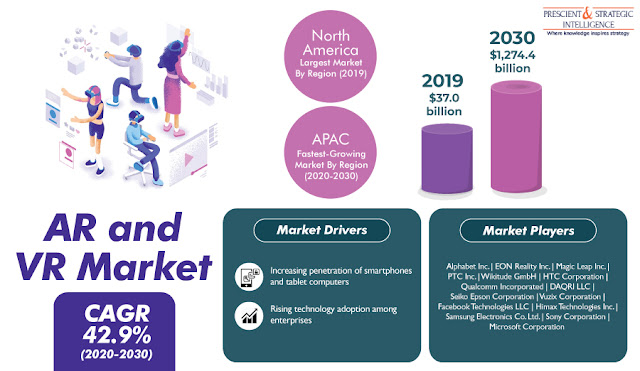From $37.0 billion in 2019, the global augmented reality (AR) and virtual reality (VR) market is predicted to reach a revenue of $1,274.4 billion by 2030. According to the estimates of the market research firm, P&S Intelligence, the market will exhibit a CAGR of 42.9% from 2020 to 2030. The market is being driven by the surging incorporation of the AR and VR technologies in the entertainment, tourism, healthcare, education, and gaming industries.
The surging adoption of the AR and VR technologies by enterprises operating in various sectors is further boosting the advancement of the AR and VR market. Major solution providers, app developers, and device manufacturing companies are increasingly targeting businesses, both small and large, owing to the wide application pool provided by them. Moreover, a large number of Fortune 500 companies have began experimenting with these solutions and some of them have already launched pilot projects.
For instance, The Boeing Company witnessed a sharp reduction in its wiring manufacturing time (by 25%) and reduced the error rate massively by utilizing smart glass displays. The other major factor driving the progress of the AR and VR market is the growing penetration of tablet computers and smartphones across the world. Through these devices, the AR and VR technologies are reaching a large number of people. Thus, the increasing use of these devices is positively impacting the demand for these technologies.
For instance, the total number of smartphone users across the world registered an increment of nearly 9.3% from 2019 and rose to around 3.5 billion by the end of 2020. When type is taken into consideration, the market is divided into AR and VR categories. Between these, the VR category contributed higher revenue to the market between 2014 and 2019. This was because of the large-scale adoption of VR in several industries, such as gaming and the falling costs of VR devices around the world.
This market research report provides a comprehensive overview of the market
The surging adoption of the AR and VR technologies by enterprises operating in various sectors is further boosting the advancement of the AR and VR market. Major solution providers, app developers, and device manufacturing companies are increasingly targeting businesses, both small and large, owing to the wide application pool provided by them. Moreover, a large number of Fortune 500 companies have began experimenting with these solutions and some of them have already launched pilot projects.
For instance, The Boeing Company witnessed a sharp reduction in its wiring manufacturing time (by 25%) and reduced the error rate massively by utilizing smart glass displays. The other major factor driving the progress of the AR and VR market is the growing penetration of tablet computers and smartphones across the world. Through these devices, the AR and VR technologies are reaching a large number of people. Thus, the increasing use of these devices is positively impacting the demand for these technologies.
For instance, the total number of smartphone users across the world registered an increment of nearly 9.3% from 2019 and rose to around 3.5 billion by the end of 2020. When type is taken into consideration, the market is divided into AR and VR categories. Between these, the VR category contributed higher revenue to the market between 2014 and 2019. This was because of the large-scale adoption of VR in several industries, such as gaming and the falling costs of VR devices around the world.
This market research report provides a comprehensive overview of the market
- The Future potential of the market through its forecast for the period 2020– 2030
- Major factors driving the market and their impact during the short, medium, and long terms
- Market restraints and their impact during the short, medium, and long terms
- Recent trends and evolving opportunities for the market participants
- Historical and the present size of the market segments and understand their comparative future potential
- Potential of on-demand logistics services, so the market players make informed decisions on the sales of their offerings

Comments
Post a Comment